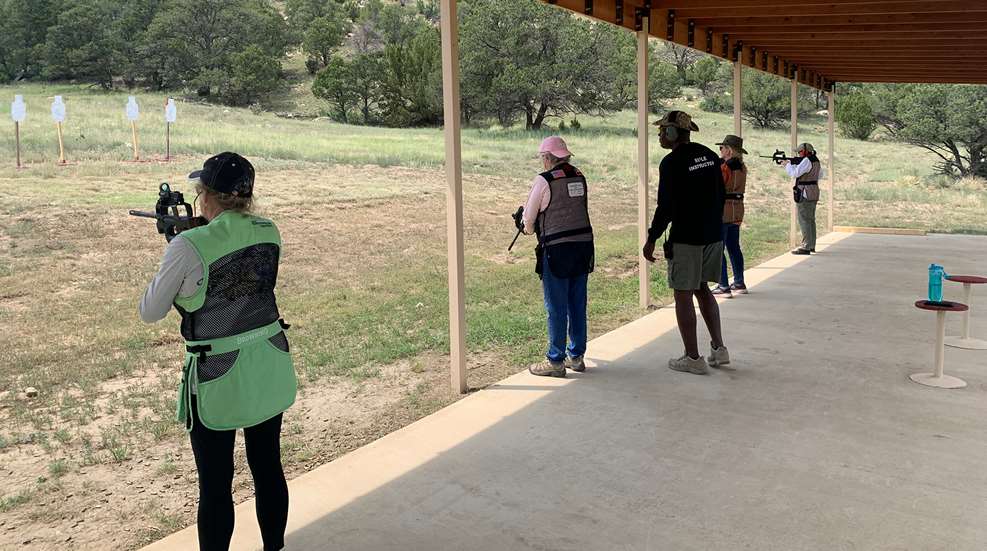
As the days become shorter and daytime temps get cooler, you start to see a noticeable increase in the number of shooters at the local gun range. Fall is in the air and sportsmen and women are getting ready for the upcoming hunting season. Handgun owners, both old and new, increase their range time due to the mild temperatures. It becomes increasingly difficult to find an open bench at the rifle range.
Safety should be the number one priority at every gun range. It does not matter if you are a first-time shooter or an experienced marksman, range safety is everyone’s responsibility. Most ranges have a Range Safety Officer (RSO) on duty anytime there are shooters on the line. The best ranges have NRA Certified RSOs.
Range Safety Officers are responsible for making sure that all safety rules and range-specific rules are followed. Every range should have a written Standard Operating Procedures (SOP) with all the rules clearly defined that guides the RSO in his or her duties. Range Safety Officers keep shooters safe, the range operating efficiently and protect range owners from liability.
Even though RSOs’ main focus is safety, it does not alleviate shooters from being safe, and in some instances, assisting the Range Safety Officer in his or her duties. At minimum, every shooter needs to know the common range commands that are used by the RSO to keep the range safe. Failing to follow range commands can put everyone, shooters and the RSO alike, at risk of serious bodily injury or worse. Every shooter needs to become familiar with the common range commands used to ensure a range runs safely and efficiently.
Cease Fire
“Cease fire” is probably the most important command given at the range. This is the only command that can be called by anyone, anywhere and at any time.. If anyone, RSO, other shooters or even a spectator, sees something unsafe or that could become a hazard, they can call a “cease fire.” At that point the RSO can decide what follow-up instructions are needed. “Cease fire” means to stop shooting, freeze in position, keep your firearm pointed downrange and wait for further instructions.
When a “cease fire” is called, freeze! Do not move. Do not unload your firearm to make safe. Do not turn around to find the person who called “Cease Fire.” Just freeze and stop what you are doing. Await further instruction from the Range Safety Officer. Many believe, incorrectly, that upon hearing the command “cease fire,” they are supposed to unload their firearm. When you hear this command, just freeze. This command could be called to change out targets, which would be followed up with the instruction to “unload.” A “cease fire” could also be called if the RSO sees someone being unsafe. If this is the case, the RSO could quickly correct the unsafe actions verbally, then tell everyone to resume shooting.
No other command is to be used in place of “cease fire.”
Range is Cold
The command “range is cold” is almost always preceded by “cease fire” and the instructions to unload, display a safe firearm (open action, remove bolt, place firearm in a gun rack, etc.), and step away from the shooting table or bench. When this command is called, no one should handle firearms or ammunition. Everyone needs to stay behind a line, usually marked behind the shooting benches, or move well behind the shooting area away from the shooting benches.
After a “range is cold” command, all shooters need to wait for further instructions from the RSO.
Down Range
The command “down range” is called to let all shooters and spectators know that one or more people are going down range in the shooting lanes. This command can be called for individuals to retrieve or put up new targets.
It is important for everyone to be vigilant during this time. If anyone approaches the shooting benches or handles firearms during this time, anyone seeing this should immediately let others, including the RSO, know.
Ready on the Right
The command “ready on the right” is called before the shooters are told to start shooting. When this command is called, the RSO looks down the right side of the shooting line to make sure everyone is ready. At this point, any shooter on the right side of the shooting line that is not ready to resume shooting should let the RSO know.
Ready on the Left
The command “ready on the left” is called before the shooters are told to start shooting. When this command is called, the RSO looks down the left side of the shooting line to make sure everyone is ready. At this point, any shooter on the left side of the shooting line that is not ready to resume shooting should let the RSO know.
Ready on the Firing Line
The command “ready on the firing line” is called after all shooters on the right and left side of the firing line acknowledge they are ready to start shooting. This command is the last check that everyone is ready to start shooting before the shooters are told to commence firing. When this command is called, the RSO looks down both the right and the left side of the shooting line to make sure everyone is ready. At this point, any shooter on the shooting line that is not ready to resume shooting should let the RSO know.
Range is Hot
The command “range is hot” means that all shooters can begin firing. After the command “range is hot” is called, the only command that can follow is “cease fire.” This means that if any safety violation or hazard occurs after the shooting has started, then a “cease fire” must be called. As stated before, the RSO or anyone else can call the “cease fire.”
On the range it is very important to listen to the RSO for commands to stay safe. Often, shooters loudly repeat, down the line, the commands—cease fire, range is cold, down range and range is hot. This ensures that everyone hears the commands. Shooting is fun and one of the safest sports to engage in. It is up to everyone to make sure that it stays that way.















































